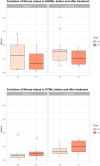Understanding the Importance of Blood-Brain Barrier Alterations in Brain Arteriovenous Malformations and Implications for Treatment: A Dynamic Contrast-Enhanced-MRI-Based Prospective Study
- PMID: 39264174
- PMCID: PMC11882286
- DOI: 10.1227/neu.0000000000003159
Understanding the Importance of Blood-Brain Barrier Alterations in Brain Arteriovenous Malformations and Implications for Treatment: A Dynamic Contrast-Enhanced-MRI-Based Prospective Study
Abstract
Background and objectives: The major clinical implication of brain arteriovenous malformations (bAVMs) is spontaneous intracranial hemorrhage. There is a growing body of experimental evidence proving that inflammation and blood-brain barrier (BBB) dysfunction are involved in both the clinical course of the disease and the risk of bleeding. However, how bAVM treatment affects perilesional BBB disturbances is yet unclear.
Methods: We assessed the permeability changes of the BBB using dynamic contrast-enhanced MRI (DCE-MRI) in a series of bAVMs (n = 35), before and at a mean of 5 (±2) days after treatment. A set of cerebral cavernous malformations (CCMs) (n = 16) was used as a control group for the assessment of the surgical-related collateral changes. The extended Tofts pharmacokinetic model was used to extract permeability (K trans ) values in the lesional, perilesional, and normal brain tissues.
Results: In patients with bAVM, the permeability of BBB was higher in the perilesional of bAVM tissue compared with the rest of the brain parenchyma (mean K trans 0.145 ± 0.104 vs 0.084 ± 0.035, P = .004). Meanwhile, no significant changes were seen in the perilesional brain of CCM cases (mean K trans 0.055 ± 0.056 vs 0.061 ± 0.026, P = .96). A significant decrease in BBB permeability was evident in the perilesional area of bAVM after surgical resection (mean K trans 0.145 ± 0.104 vs 0.096 ± 0.059, P = .037). This benefit in BBB permeability reduction after surgery seemed to surpass the relative increase in permeability inherent to the surgical manipulation.
Conclusion: In contrast to CCMs, BBB permeability in patients with bAVM is increased in the perilesional parenchyma, as assessed using DCE-MRI. However, bAVM surgical resection seems to reduce BBB permeability in the perilesional tissue. No evidence of the so-called breakthrough phenomenon was detected in our series. DCE-MRI could become a valuable tool to follow the longitudinal course of BBB damage throughout the natural history and clinical course of bAVMs.
Copyright © 2024 The Author(s). Published by Wolters Kluwer Health, Inc. on behalf of the Congress of Neurological Surgeons.
Figures




References
-
- Nornes H, Grip A. Hemodynamic aspects of cerebral arteriovenous malformations. J Neurosurg. 1980;53(4):456-464. - PubMed
-
- Sahlein DH, Mora P, Becske T, et al. Features predictive of brain arteriovenous malformation hemorrhage: extrapolation to a physiologic model. Stroke. 2014;45(7):1964-1970. - PubMed
-
- Lawton MT, Rutledge WC, Kim H, et al. Brain arteriovenous malformations. Nat Rev Dis Primers. 2015;1:15008. - PubMed
-
- Guest W, Krings T. Brain arteriovenous malformations: the role of imaging in treatment planning and monitoring response. Neuroimaging Clin N Am. 2021;31(2):205-222. - PubMed
-
- Rutledge C, Cooke DL, Hetts SW, Abla AA. Brain arteriovenous malformations. Handb Clin Neurol. 2021;176:171-178. - PubMed
MeSH terms
Substances
Grants and funding
LinkOut - more resources
Full Text Sources
Medical

